
HRBT EXPANSION
2023 Temporary Marine Trestles 4 6
Winter
TBM Cutterhead Installed
14 INTHIS ISSUE 11
HRBT Celebrates 65Years Driving STEM Education
TABLE OF CONTENTS

Message from Jim Utterback
We have made significant progress on the HRBT Expansion Project since construction began almost 2 ½ years ago. The hard work of our project team is visible in the new bridge structures, assembly of the Tunnel Boring Machine and Slurry Treatment Plant on South Island, as well as the progress to support the roadway widening in both Hampton and Norfolk. Even considering all we have accomplished to date, 2023 will be even more meaningful with the beginning of tunneling operations later this spring.
It has been my honor to serve as the VDOT Project Director for this critical infrastructure improvement for the last five years, and I am thankful for the chance to help shape the future of Hampton Roads. My decision to retire from VDOT was not made easily and although I may not be at the Project Office, I will always be there in spirit. I know the Project team is up to the challenge and just as each of you, I look forward to the day we can drive through the new tunnels.
A final thought, as you travel, please stay alert for changing traffic patterns, obey posted speed limits, and watch out for crews in the work zones: everyone needs to make it home safe.
James S. Utterback HRBTExpansion Project Director

Project Updates ................................. 3 Construction Update .................. 4-5 TBM Update ................................... 6-7 Island Update ..................................... 8 Staff Spotlight ................................... 9 Environmental Update ...................10 HRBT Celebrates 65 Years 11-13 Outreach Update 14-15
2 HRBT EXPANSION MAGAZINE | Winter 2023 HRBT EXPANSION
PROJECTUPDATES
Construction is progressing along all 10 miles of the project corridor. Most visible on the project, the new permanent marine trestle bridges are taking shape across the harbor, as crews start building the bridge decks. Motorists can also see significant progress on the roadway with the widening of the interstate, overpasses and bridges. New sound walls featuring a Navy frigate emblem have started being installed along the interstate in Norfolk.
At the South Island, the assembly of the Slurry Treatment Plant is clearly visible on the north end of the island. Less visible, but of significance, the “headwall” in the Launch Pit is complete. This significant concrete structure is the first element that the Tunnel Boring Machine (TBM) will bore through as it leaves the Launching Pit and begins its journey to the North Island. The precast concrete plant at Cape Charles has been actively engaged forming the ring segments which will comprise the outer tunnel structure. Over 50% of the necessary segments have now been completed. At the North Island, crews are busy preparing for the excavation of the Receiving Pit where the TBM will be reversed and sent back to South Island, and in doing so, completing the second tunnel. It’s critical that the Receiving Pit be completed and ready to accept the TBM as it completes its trip from South Island.


Half a Billion Opportunities for Small Business

The Hampton Roads Bridge-Tunnel (HRBT) Expansion Project recently achieved a milestone by awarding a cumulative total of over $500 million in contracts to Virginiacertified Disadvantaged Business Enterprise (DBE) and Small, Women, and Minority (SWaM) vendors working on the project.




326 Executed Agreements totaling $501.7 Million in Contract Awards to DBE and SWaM businesses

SOUTH ISLAND LAUNCH PIT
SOUTH TRESTLE
NORTH TRESTLE
NORTH ISLAND
MARY THE TBM
I-64 WIDENING IN NORFOLK 3 www.hrbtexpansion.org
Temporary Trestles Enable Permanent Progress
TRAFFIC
The Hampton Roads Bridge-Tunnel is a critical gateway to South Hampton Roads, with as many as 100,000 motorists using the facility daily during peak summer months. The Virginia Department of Transportation (VDOT) understands the importance of maintaining this essential travel route during construction.

One of the challenges of this project was the requirement to construct the entire project within the existing VDOT rightof-way. The project team was careful and deliberate as they planned the sequence and location of the work, always recognizing that it was critical to minimize impacts to residents and motorists.
Over the water, the team identified three temporary bridges that would be necessary to allow the work to proceed and the new structures to be completed. Without these temporary structures, it would be impossible to maintain traffic while demolishing the existing bridges and constructing the new ones. In a complex choreographed dance, traffic is shifted from permanent to temporary and finally back to permanent bridges.
SEQUENCE OF CONSTRUCTION
CONSTRUCTION
UPDATE
Build Temporary Bridge 1 STEP Shift Traffic to Temporary Bridge 2 STEP Demolish Existing Bridge 3 STEP Build New Permanent Structure 4 STEP Shift Traffic to New Permanent Structure 5 STEP Remove the Temporary Bridge 6 STEP
4 HRBT EXPANSION MAGAZINE | Winter 2023
Many have noticed that the temporary bridges have steel piles instead of concrete piles driven into the seabed. Steel piles provide the necessary support for the bridges and – topped with pile caps, girders and bridge deck –function just like a permanent structure. However, steel piles are typically not used for permanent structures because steel is more susceptible to saltwater over a long period of time. Since the temporary bridges will be in place for only a few years, the steel piles will make it easier for the temporary bridges to be removed after traffic is shifted to the new permanent structures.



While it may not be intuitive to build and remove temporary bridges, the ability to keep traffic moving during construction far outweighs the cost. The ingenuity and complexity of this phased construction approach will keep Virginia moving throughout the HRBT Expansion.


South Trestle
North Trestle
I-64 West to Hampton
I-64 East to Norfolk
PLAN
PROGRESS PROGRESS
I-64 East to Norfolk
PLAN
5 www.hrbtexpansion.org
HRBT EXPANSION
Heads Up: Cutterhead installed on TBM

The cutterhead for Mary, the tunnel boring machine (TBM), is a symbolic “face” of the HRBT Expansion Project with its custom blue, green and white design modeled after the Hampton Roads regional flag. The cutterhead houses 235 tools – disc cutters, scrapers, and center tools – that will be used for excavation of the new tunnels. As the entire cutterhead rotates about 1.5 rpm, these tools will scrape and dig out the soil. The TBM was innovatively designed so that many of the tools can be replaced from inside the machine, simplifying regular maintenance to keep the tools sharp for excavation.
 [ BELOW ]: 1 Two cranes work in sync to lift the TBM cutterhead.
[ BELOW ]: 1 Two cranes work in sync to lift the TBM cutterhead.
TBM UPDATE
6 HRBT EXPANSION MAGAZINE | Winter 2023
Scan the QR code to watch a timelapse video of the cutterhead lift.
The cutterhead arrived on the South Island in seven primary sections - one center piece and six wedge-shaped spokes. While the cutterhead sections came with most of the tools installed, there was still significant work required to join the sections. It took crews months of welding to connect the seven sections into one massive cutterhead weighing 475 US tons.
Simultaneously, crews focused on building the foundation or “cradle” to support the TBM in the launch shaft and then assembling the circular shield sections and main drive at the front of the TBM. All of this preparation work allowed installing the cutterhead onto the TBM in January 2023. Given its weight as the heaviest single lift on the project, raising and moving the TBM

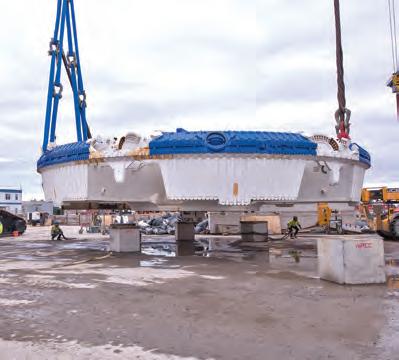



cutterhead was no small feat. Crews used two massive cranes working in concert to carefully maneuver the cutterhead into a vertical position before it could be lowered into the launch pit.
This milestone takes us one step closer to the start of boring, which is anticipated in Spring 2023.
[ LEFT TO RIGHT ]: 2 A view of the TBM shield from the first trailing gantry. 3 The TBM cutterhead is lowered into place. 4 Cranes lift the TBM cutterhead so crews can remove the concrete support blocks. 5 The crane swings the TBM cutterhead into position over the launch pit.
6 VDOT Project Director Jim Utterback and HRCP Project Manager Louis Brais take a minute to celebrate the progress.
7 www.hrbtexpansion.org HRBT EXPANSION
Preparing for Mary’s Arrival at North Island
Mary will excavate and construct the first tunnel as she heads from the South Island to the North Island. Meanwhile, crews are busily preparing the North Island “receiving pit” for Mary’s arrival.
To accommodate the two new tunnels, the North Island was nearly doubled in size with the addition of 15 acres. Once the expansion was completed, crews then prepared for excavating a specific area of the newly laid soil to create the TBM receiving pit. While the TBM launch pit was constructed of three overlapping circles in a peanut shape, the receiving pit consists of just one circle adjacent to a rectangle, similar to a keyhole shape. This design serves multiple purposes, with the rectangular portion both providing space to turn the TBM around and also accommodating the future approach roadway for the new tunnels.
The slurry walls, which form the perimeter of the receiving pit, are designed to hold back the soil and groundwater to allow crews to excavate within the structure. After installing a capping beam around the perimeter of the slurry walls , crews will excavate the receiving pit to a depth of 75 feet. Then, a specially engineered waterproofing system will be installed to control groundwater from seeping into the pit over its 100-year design life. This system, comprised of geo-textile material, waterproof PVC membrane, water-stop barriers
and seals, is installed on the walls and floor of the shaft. Finally, crews will construct an eight-foot-thick reinforced concrete slab at the base of the receiving pit.

Traveling at up to fifty feet per day, depending on soil conditions and maintenance requirements, Mary will complete her 8,000-foot journey to arrive at the North Island after approximately one year. After breaking through into the receiving pit, Mary will be turned 180 degrees and repositioned to begin boring the second tunnel. This turn-around process, including the shield and four trailing gantries that make up Mary, will take roughly six months. Then Mary will be on her way back to the South Island, as she builds the second tunnel.

ISLAND UPDATE
Crews prepare to begin excavation of the TBM receiving pit.
8 HRBT EXPANSION MAGAZINE | Winter 2023
Reinforced steel is used in the capping beam to provide support to the TBM receiving pit.
LEGO HRBT CONTEST WINNER

Foran internal HRBTProject contest, team members and their familieswere recently invited to design a Lego® structure, using a maximum of 30 pieces, that is representativeoftheproject.
George’s ten-year-old daughter Lavenia, a skilled Lego® builder, createdthewinningentry:areplica of“Mary,theTunnelBoringMachine,”incorporatingtheTBM’s blue,white, and green cutterhead aswell as the trademark light-greencoloroftheTBMmanufacturerHerrenknecht. EngineeringskillsclearlyrunintheMankarousfamily!
GEORGE MANKAROUS HRCP Project Engineer
Egyptian-born George Mankarous grew up surrounded by ancient structures in Luxor, the old capital city of Egypt. Inspired, he pursued his architectural engineering degree and has been building large-scale projects ever since. From Egypt to Qatar, George made his way to the United States in 2019. George and his family lived in the Boston area for several years when the call of a big challenge brought him to Hampton Roads and the HRBT Expansion Project.
George is a project engineer responsible for the 19 new buildings and the internal structures for the tunnel approaches on both islands, as well as the renovation of the existing HRBT administration building. He is excited about witnessing the tunnel boring part of this project.

George and his wife have three beautiful daughters, each born in a different country, with his newest addition a true Hampton Roads-born native. His family enjoys living close to the beach and they’ve made a lot of new friends here, so they are excited to call Hampton Roads home.
George and his daughter Lavenia partnered to construct this winning 30 piece Lego® structure.

HRBT EXPANSION
9 www.hrbtexpansion.org
Sound Protection for Marine Animals
If you have ever heard pile driving at a construction site, the sound is unforgettable. Due to the relatively soft soils throughout Hampton Roads, many structures in this area rely on pilings – essentially long posts made of concrete, steel, or timber –which are driven deep underground to support and stabilize buildings and bridges.
To provide a solid foundation for the new and widened HRBT bridges, crews are installing more than 1,000 steel and concrete piles throughout the project corridor, both on land and over water. Although the unmistakable sound of pile driving dissipates quickly in the air, the reverberations from marine pile driving can travel extensively underwater.
Because sea creatures, and marine mammals in particular, are sensitive to underwater noises, the HRBT Project has implemented protective measures – as reviewed by the National Oceanic and Atmospheric Administration (NOAA) Fisheries office and approved in a Letter of Authorization –to control the propagation and effect of sound waves underwater.
To mitigate the potential effects of the sound on our marine wildlife, the project employs a range of strategies depending on water depth and piling type. Much of the water around the HRBT marine bridges is shallow, which naturally helps limit the extent of vibrations that would otherwise travel in deeper water. And concrete piles, due to their greater mass relative to steel piles, inherently help dampen underwater sound waves as these heavy piles are driven.
Using a “soft start” for pile driving – giving each pile a few taps with the impact hammer, then waiting briefly before starting full operations – effectively alerts sea creatures that a loud operation is about to begin. With this “heads-up,” fish and marine mammals are instinctively able to seek out quieter areas of the harbor before pile driving operations proceed.
When driving steel piles in deeper water, project crews also employ devices called “bubble curtains” to absorb the energy and soften the impact of the underwater pressure waves. These bubble curtains typically consist of hollow metal rings, which are lowered underwater to surround the pilings. As the piles are driven, pressurized air is simultaneously pumped through these perforated rings, creating a continuous cloud of bubbles rising to the surface around each pile.

This wall of bubbles absorbs the acoustic energy released when the pile is struck, changing the shape of the pressure waves and reducing the underwater decibel level. Due to the difference in density between air and water, air provides a particularly effective barrier to sound propagating through water. These measures help ensure the project remains a good neighbor to the dolphins and other marine creatures with whom we share the Hampton Roads waterway during the construction process.

ENVIRONMENTAL UPDATE HRBT EXPANSION
10 HRBT EXPANSION MAGAZINE | Winter 2023
Confined bubble curtains protect marine life during pile driving activities.
Notable from the beginning
On November 1, 1957, a ribbon cutting ceremony was held for a futuristic new public works project. At a cost of $60 million, the new Hampton Roads BridgeTunnel (HRBT) presented an innovative combination of two bridges and a tunnel, spanning the 3.5-mile distance from Norfolk to Hampton.

A tunnel was necessary to maintain unrestricted marine access for the country’s largest naval base. However, the available ventilation technology in the 1950’s could not accommodate a 3.5-mile tunnel. The solution was the world’s first tunnel between two artificial islands – a shorter distance
that could safely be ventilated – and connected to shore by trestle bridges over the shallow water outside the main shipping channel.
At the time, measuring almost 7,500 feet from portal to portal, the HRBT was the world’s longest immersed-tube tunnel, consisting of 23 prefabricated tunnel segments placed within a trench along the floor of the harbor. The steel tube segments – about 300 feet long, 37 feet in diameter and 12,000 tons each – were fabricated in Chester, Pennsylvania and floated down the Chesapeake Bay to a yard at Lambert’s Point in Norfolk. There, each segment received an 18inch concrete pour on its roadway slab

Built in 1957, the original Hampton Roads BridgeTunnel was an engineering marvel.

and an additional fit-out before being towed to its final destination.
A necessary improvement
Prior to the opening of the HRBT, VDOT operated ferries to carry traffic across the harbor from the Southside to the Peninsula. There were two routes: one from Hampton Boulevard near Naval Station Norfolk to downtown Newport News, and a second, less traveled route from Willoughby Spit to Fort Monroe in Hampton. Total traffic at the time was typically about 2500 vehicles per day. The closest alternative was a 25-mile detour via Rt. 17 and the James River Bridge.

THEN NOW
HRBT EXPANSION HAPPY ANNIVERSARY | HAPPY ANNIVERSARY | HAPPY ANNIVERSARY
11 www.hrbtexpansion.org
Hampton Roads Bridge Tunnel
The opening of the two-lane HRBT in 1957 reduced travel time across the harbor from a 30-minute ferry ride –plus waiting time – to a seven-minute drive. Virginia’s chairman of the State Highway Commission, Gen. James A. Anderson, summarized it well at the grand opening: “With this bridge-tunnel, we have destroyed distance and conquered time.”



Initial traffic estimates predicted daily HRBT use would grow to 10,000 vehicles by 1980, but traffic volumes reached this level by 1964, even with a $1.25 toll (matching the 1957 ferry fare, and equivalent to over $13 in today’s dollars). A second tunnel, with parallel bridges, was opened in 1976. After tolls were removed, daily traffic volumes on these four lanes surpassed 40,000 vehicles by 1978, and 80,000 vehicles by 1985.
Building for the future

Today, with more than 100,000 vehicles crossing the HRBT daily during peak season, this historic facility is an integral part of keeping the region and Virginia moving.




The Hampton Roads region has experienced tremendous growth since the original bridge-tunnel was constructed, from a population of just over 500,000 to now more than 1.8 million. The HRBT Expansion Project will provide needed capacity and prepare the region for the future. And with high-durability materials such as carbon fiber and stainless steel targeting a 100-year design life, the new HRBT structures will continue to serve the region for the foreseeable future.

THEN THEN NOW NOW
North Trestle
12 HRBT EXPANSION MAGAZINE | Winter 2023
South Trestle
HRBT EXPANSION HAPPY ANNIVERSARY | HAPPY ANNIVERSARY | HAPPY ANNIVERSARY
These marine bridges built in 1957 are 9,000 feet across Hampton Roads Waterway. Equal to 25 football fields in length.
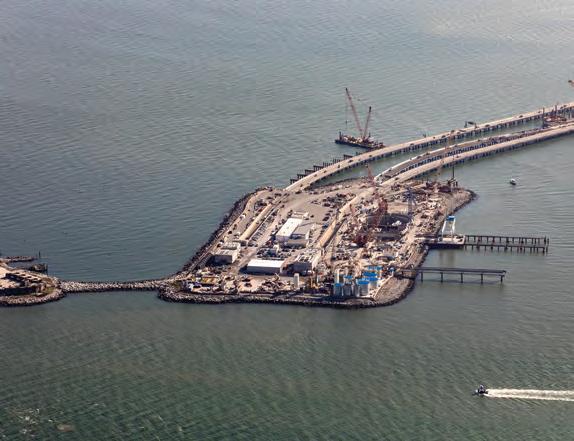


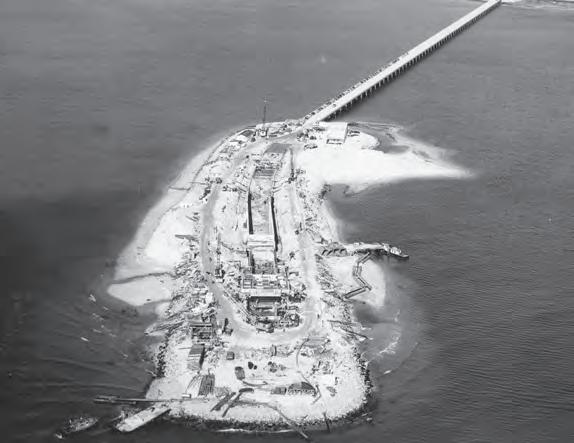

DID YOU KNOW? IN 1957
Elvis joins the Army. Queen Elizabeth II visits Williamsburg. The first Frisbee was sold.
“Leave It to Beaver” debuts. The Dodgers move to Los Angeles.
World Changing Event: The Soviet Union launches Sputnik, the first space satellite, starting the Space Race. The first tube of the Hampton Roads Bridge Tunnel (HRBT) is opened.
THEN THEN
North Island
NOW NOW

South Island

13 www.hrbtexpansion.org
The Next Generation
Counting direct and indirect employment, the HRBT Expansion Project is expected to create more than 28,000 jobs, generating an economic impact of more than $4.6 billion over the life of the project. Those jobs include planners, environmental specialists, design and field engineers, craft workers, and site supervisors, as well as administrative, procurement, and related support services.
The HRBT Expansion Project provides an exceptional illustration of the range of real-world opportunities available in the STEM (Science, Technology, Engineering and Math) arena. While some STEM jobs

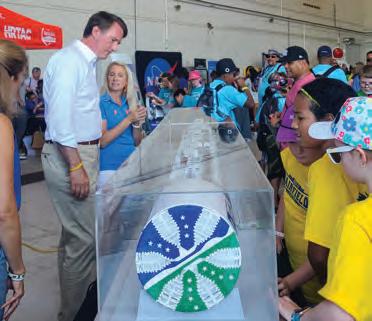

at HRBT are highly technical, others focus on field problem-solving and practical know-how. Encouraging students to consider and explore STEM careers is the key to developing the next generation of engineering and construction workers. In addition to college-based careers, students also have opportunities at HRBT to learn a construction trade directly after high school through the project’s structured On-the-Job Training (OJT) program. This program offers paid training in high-demand, transferable skills such as carpenter, laborer, mechanic, and pile driver. Trainees learn both by observing others and by hands-on experience completing tasks under the supervision of a manager or coworker. To date, over 28 tradesmen and tradeswomen have graduated from the project’s OJT program
and earned a certificate of completion for their new skills. OJT opportunities and other craft openings are posted at www.HRCPjobs.com.
From elementary students to even Governor Glenn Youngkin, everyone is curious about the largest highway infrastructure project in the history of Virginia. The HRBT Expansion team is excited to share updates with the entire community, from the youngest to the young-at-heart. By promoting STEM learning through the project’s informative resources, the team hopes that observing the HRBT Expansion Project in their own backyard may spark the curiosity and desire in local students to explore becoming the next generation of engineers and constructors.
OUTREACH UPDATE
The model for Mary the TBM is on display as the Governor visits the NAS Oceana Air Show.
Governor Youngkin visits the HRBT Expansion Project booth during the NAS Oceana Air Show STEM event.
14 HRBT EXPANSION MAGAZINE | Winter 2023
Students from the University of Illinois inside the demonstration tunnel ring.
HAMPTON ROADS BRIDGE-TUNNEL EXPANSION PROJECT TUNNELING PROCESS



STEM Education for All Ages

WHAT GOES INTO BUILDING A TUNNEL?
Scan the QR code to explore all the activities for the HRBT Expansion Project tunneling process with an interactive tool.


 HRBT Project team brought the model of Mary the TBM along with educational materials to share during the Air Show’s STEM day for Virginia Beach Public Schools and other students.
University of Illinois students visit Cape Charles to learn about the tunnel segments.
Hampton University engineering students tour the South Island.
HRBT Project team brought the model of Mary the TBM along with educational materials to share during the Air Show’s STEM day for Virginia Beach Public Schools and other students.
University of Illinois students visit Cape Charles to learn about the tunnel segments.
Hampton University engineering students tour the South Island.
15 www.hrbtexpansion.org HRBT EXPANSION
An overview of the complex planning, engineering and construction progress behind the new HRBT twin tunnels.
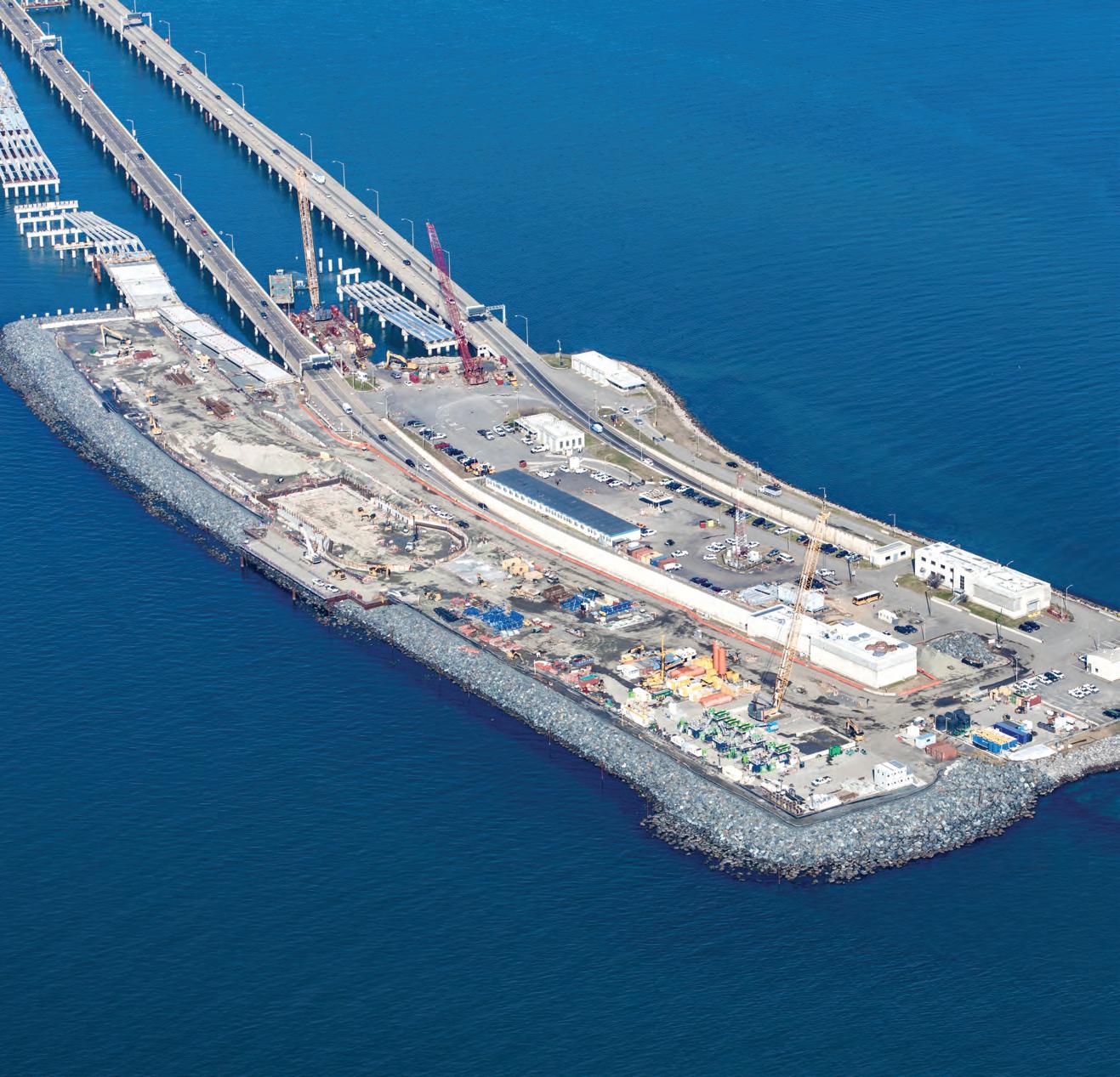
HRBT EXPANSION



















 [ BELOW ]: 1 Two cranes work in sync to lift the TBM cutterhead.
[ BELOW ]: 1 Two cranes work in sync to lift the TBM cutterhead.









































 HRBT Project team brought the model of Mary the TBM along with educational materials to share during the Air Show’s STEM day for Virginia Beach Public Schools and other students.
University of Illinois students visit Cape Charles to learn about the tunnel segments.
Hampton University engineering students tour the South Island.
HRBT Project team brought the model of Mary the TBM along with educational materials to share during the Air Show’s STEM day for Virginia Beach Public Schools and other students.
University of Illinois students visit Cape Charles to learn about the tunnel segments.
Hampton University engineering students tour the South Island.
